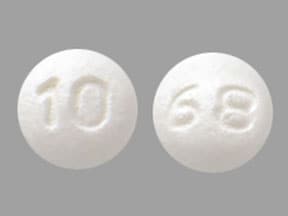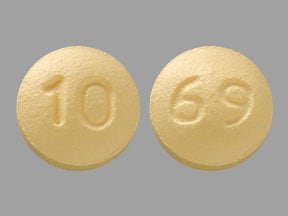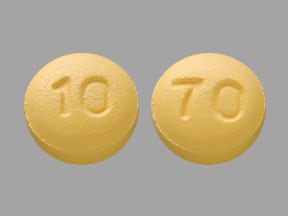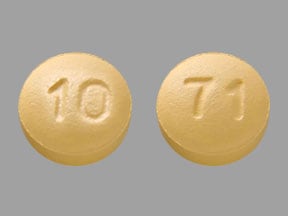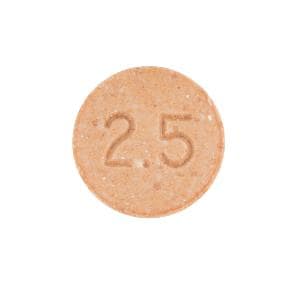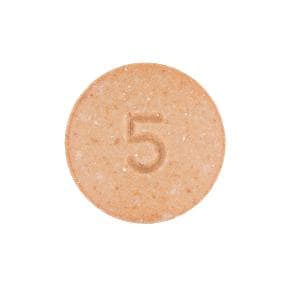Dosage Forms
Excipient information presented when available (limited, particularly for generics); consult specific product labeling. [DSC] = Discontinued product
Tablet, Oral:
Levitra: 2.5 mg [DSC], 5 mg [DSC], 10 mg, 20 mg
Generic: 2.5 mg, 5 mg, 10 mg, 20 mg
Tablet Disintegrating, Oral:
Staxyn: 10 mg [contains aspartame; peppermint flavor]
Generic: 10 mg
Pharmacology
Mechanism of Action
Does not directly cause penile erections, but affects the response to sexual stimulation. The physiologic mechanism of erection of the penis involves release of nitric oxide (NO) in the corpus cavernosum during sexual stimulation. NO then activates the enzyme guanylate cyclase, which results in increased levels of cyclic guanosine monophosphate (cGMP), producing smooth muscle relaxation and inflow of blood to the corpus cavernosum. Vardenafil enhances the effect of NO by inhibiting phosphodiesterase type 5 (PDE-5), which is responsible for degradation of cGMP in the corpus cavernosum; when sexual stimulation causes local release of NO, inhibition of PDE-5 by vardenafil causes increased levels of cGMP in the corpus cavernosum, resulting in smooth muscle relaxation and inflow of blood to the corpus cavernosum; at recommended doses, it has no effect in the absence of sexual stimulation.
Pharmacokinetics/Pharmacodynamics
Absorption
Rapid
Distribution
Vd: 208 L
Metabolism
Hepatic via CYP3A4 (major), CYP2C and 3A5 (minor); forms metabolite (active)
Excretion
Feces (~91% to 95% as metabolites); urine (~2% to 6%)
Onset of Action
~60 minutes
Time to Peak
Plasma: 0.5 to 2 hours
Half-Life Elimination
Terminal: Vardenafil and metabolite: 4 to 6 hours
Protein Binding
~95% (parent drug and metabolite)
Use in Specific Populations
Special Populations: Renal Function Impairment
The AUC was 20% to 30% higher in moderate (CrCl 30 to 50 mL/minute) and severe (CrCl <30 mL/minute) renal impairment.
Special Populations: Hepatic Function Impairment
In patients with mild hepatic impairment (Child-Pugh class A), Cmax and AUC increased by 22% and 17%, respectively. In patients with moderate hepatic impairment (Child-Pugh class B), Cmax and AUC increased by 130% and 160%, respectively.
Special Populations: Elderly
In men ≥65 years of age, the Cmax and AUC are increased 34% and 52%, respectively, for Levitra and by 21% and 39%, respectively, for Staxyn compared with men <45 years.
Use: Labeled Indications
Erectile dysfunction: Treatment of erectile dysfunction (ED)
Use: Off Label
Raynaud phenomenonb
Data from a meta-analysis and a small controlled trial support the use of vardenafil for Raynaud phenomenon related to systemic sclerosis, demonstrating a decrease in the frequency and severity of attacksCaglayan 2012, Roustit 2013.
Contraindications
Coadministration with nitrates (either regularly and/or intermittently), nitric oxide donors, or guanylate cyclase stimulators (eg, riociguat).
Canadian labeling: Additional contraindications (not in US labeling): Hypersensitivity to vardenafil or any component of the formulation; concomitant use with indinavir, ritonavir, ketoconazole or itraconazole (Levitra, Staxyn) and erythromycin or clarithromycin (Staxyn); prior episode of non-arteritic anterior ischemic optic neuropathy (NAION).
Dosage and Administration
Dosing: Adult
Note: Oral disintegrating tablets should not be used interchangeably with film-coated tablets; patients requiring a dose other than 10 mg should use the film-coated tablets.
Erectile dysfunction: Oral:
Film-coated tablet (Levitra): 10 mg administered ~60 minutes prior to sexual activity; dosing range: 5 to 20 mg; taken as one single dose and not taken more than once daily; maximum 20 mg daily
Oral disintegrating tablet (Staxyn): 10 mg administered ~60 minutes prior to sexual activity; maximum: 10 mg daily
Raynaud phenomenon (off-label use): Oral: 10 mg twice daily. The treatment period in clinical trials was up to 6 weeks (Caglayan 2006; Caglayan 2012).
Dosing adjustment with concomitant medications:
Alpha-blocker (dose should be stable at time of vardenafil initiation):
Film-coated tablet (Levitra): Initial vardenafil dose: 5 mg taken no more than once daily; if an alpha-blocker is added to vardenafil therapy, it should be initiated at the smallest possible dose and titrated carefully.
Oral disintegrating tablet (Staxyn): Do not use to initiate therapy. Initial therapy should be with film-coated tablets at lower doses. Patients who have previously used film-coated tablets may be switched to oral disintegrating tablets as recommended by healthcare provider. With coadministration, consider a time interval between dosing (eg, 6-hour interval).
CYP3A4 inhibitors:
Film-coated tablet (Levitra): The dosage of vardenafil may require adjustment in patients receiving potent CYP3A4 inhibitors (eg, atazanavir, clarithromycin, erythromycin, indinavir, itraconazole, ketoconazole, ritonavir, saquinavir).
For ritonavir, a single dose of vardenafil 2.5 mg should not be exceeded in a 72-hour period.
For indinavir, saquinavir, atazanavir, ketoconazole 400 mg daily, itraconazole 400 mg daily, and clarithromycin, a single dose of vardenafil 2.5 mg should not be exceeded in a 24-hour period.
For ketoconazole 200 mg daily, itraconazole 200 mg daily, and erythromycin, a single dose of vardenafil 5 mg should not be exceeded in a 24-hour period.
Oral disintegrating tablet (Staxyn): Concurrent use not recommended with potent or moderate CYP3A4 inhibitors (atazanavir, clarithromycin, erythromycin, indinavir, itraconazole, ketoconazole, ritonavir, saquinavir)
Dosing: Geriatric
Erectile dysfunction: Elderly ≥65 years: Film-coated tablet (Levitra): Oral: Consider a starting dose of 5 mg administered ~60 minutes prior to sexual activity; taken as one single dose and not taken more than once daily.
Administration
May be administered with or without food, approximately 60 minutes prior to sexual activity.
Oral disintegrating tablet should not be removed from blister pack until administered. Using dry hands, place immediately on tongue. Tablet will dissolve within seconds; do not take with liquid. Do not crush, split, or chew.
Dietary Considerations
Some products may contain phenylalanine. Some products may contain sorbitol; do not use in patients with fructose intolerance.
Storage
Store at 25°C (77°F); excursions permitted to 15°C to 30°C (59°F to 86°F). Keep oral disintegrating tablets sealed in blisterpack until ready to use.
Vardenafil Images
Drug Interactions
Alcohol (Ethyl): May enhance the hypotensive effect of Phosphodiesterase 5 Inhibitors. Monitor therapy
Alpha1-Blockers (Nonselective): Phosphodiesterase 5 Inhibitors may enhance the hypotensive effect of Alpha1-Blockers (Nonselective). Management: Ensure patient is stable on one agent prior to initiating the other, and always initiate combination using the lowest possible dose of the drug being added. When tadalafil is used for treatment of BPH, concurrent alpha 1-blockers are not recommended. Consider therapy modification
Alpha1-Blockers (Uroselective): May enhance the hypotensive effect of Phosphodiesterase 5 Inhibitors. Monitor therapy
Alprostadil: Phosphodiesterase 5 Inhibitors may enhance the adverse/toxic effect of Alprostadil. Avoid combination
Amyl Nitrite: Phosphodiesterase 5 Inhibitors may enhance the vasodilatory effect of Amyl Nitrite. Avoid combination
Aprepitant: May increase the serum concentration of CYP3A4 Substrates (High risk with Inhibitors). Monitor therapy
Blood Pressure Lowering Agents: Phosphodiesterase 5 Inhibitors may enhance the hypotensive effect of Blood Pressure Lowering Agents. Monitor therapy
Bosentan: May decrease the serum concentration of Phosphodiesterase 5 Inhibitors. Phosphodiesterase 5 Inhibitors may increase the serum concentration of Bosentan. Monitor therapy
Clarithromycin: May increase the serum concentration of Vardenafil. Management: Recommendations regarding the concomitant use of vardenafil with clarithromycin vary between international labelings and between commercially available vardenafil brand name products (Levitra, Staxyn). Consult appropriate product labelings. Consider therapy modification
Clofazimine: May increase the serum concentration of CYP3A4 Substrates (High risk with Inhibitors). Monitor therapy
Cobicistat: May increase the serum concentration of Vardenafil. Management: Recommendations regarding use of vardenafil with cobicistat-containing products vary by vardenafil product and by country. See full drug interaction monograph for details. Consider therapy modification
Conivaptan: May increase the serum concentration of CYP3A4 Substrates (High risk with Inhibitors). Avoid combination
CYP3A4 Inhibitors (Moderate): May decrease the metabolism of CYP3A4 Substrates (High risk with Inhibitors). Monitor therapy
CYP3A4 Inhibitors (Strong): May increase the serum concentration of Vardenafil. Management: Recommendations regarding concomitant use of vardenafil with strong CYP3A4 inhibitors may vary depending on brand name (e.g., Levitra, Staxyn) or by international labeling. See full drug interaction monograph for details. Consider therapy modification
Dapoxetine: May enhance the orthostatic hypotensive effect of Phosphodiesterase 5 Inhibitors. Avoid combination
Duvelisib: May increase the serum concentration of CYP3A4 Substrates (High risk with Inhibitors). Monitor therapy
Erdafitinib: May increase the serum concentration of CYP3A4 Substrates (High risk with Inhibitors). Monitor therapy
Erythromycin (Systemic): May increase the serum concentration of Vardenafil. Management: Limit dose of vardenafil film-coated tablets (Levitra) to 5 mg per 24 hours with concomitant use of erythromycin. Concomitant use of vardenafil orally disintegrating tablets (Staxyn) with erythromycin is not recommended. Consider therapy modification
Etravirine: May decrease the serum concentration of Phosphodiesterase 5 Inhibitors. Monitor therapy
Fluconazole: May increase the serum concentration of Vardenafil. Management: Limit vardenafil doses to a maximum of 5 mg per 24-hour period in patients receiving concurrent therapy with a moderate CYP3A4 inhibitor such as fluconazole. Consider therapy modification
Fosaprepitant: May increase the serum concentration of CYP3A4 Substrates (High risk with Inhibitors). Monitor therapy
Fosnetupitant: May increase the serum concentration of CYP3A4 Substrates (High risk with Inhibitors). Monitor therapy
Fusidic Acid (Systemic): May increase the serum concentration of CYP3A4 Substrates (High risk with Inhibitors). Avoid combination
Haloperidol: QT-prolonging Agents (Indeterminate Risk - Avoid) may enhance the QTc-prolonging effect of Haloperidol. Monitor therapy
Idelalisib: May increase the serum concentration of CYP3A4 Substrates (High risk with Inhibitors). Avoid combination
Itraconazole: May increase the serum concentration of Vardenafil. Management: Limit vardenafil to a max of 5 mg/24 hours in patients receiving itraconazole 200 mg/day, and a max of 2.5 mg/24 hours in patients receiving itraconazole 400 mg/day. Itraconazole labeling and Staxyn brand of vardenafil both recommend avoiding this combo. Consider therapy modification
Ketoconazole (Systemic): May increase the serum concentration of Vardenafil. Management: Limit vardenafil dosing to a maximum of 5 mg per 24 hours in patients receiving ketoconazole 200 mg/day, and a maximum of 2.5 mg per 24 hours in patients receiving ketoconazole 400 mg/day. Consider therapy modification
Larotrectinib: May increase the serum concentration of CYP3A4 Substrates (High risk with Inhibitors). Monitor therapy
Lorcaserin: May enhance the adverse/toxic effect of Phosphodiesterase 5 Inhibitors. Specifically, the risk of developing priapism may be increased. Monitor therapy
MiFEPRIStone: May increase the serum concentration of CYP3A4 Substrates (High risk with Inhibitors). Management: Minimize doses of CYP3A4 substrates, and monitor for increased concentrations/toxicity, during and 2 weeks following treatment with mifepristone. Avoid cyclosporine, dihydroergotamine, ergotamine, fentanyl, pimozide, quinidine, sirolimus, and tacrolimus. Consider therapy modification
Molsidomine: May enhance the hypotensive effect of Phosphodiesterase 5 Inhibitors. Avoid combination
Netupitant: May increase the serum concentration of CYP3A4 Substrates (High risk with Inhibitors). Monitor therapy
Nitroprusside: Phosphodiesterase 5 Inhibitors may enhance the hypotensive effect of Nitroprusside. Avoid combination
Palbociclib: May increase the serum concentration of CYP3A4 Substrates (High risk with Inhibitors). Monitor therapy
Phosphodiesterase 5 Inhibitors: May enhance the adverse/toxic effect of other Phosphodiesterase 5 Inhibitors. Avoid combination
Posaconazole: May increase the serum concentration of Vardenafil. Management: Limit vardenafil dosing to a maximum of 2.5 mg per 24 hours in patients receiving concurrent therapy with strong CYP3A4 inhibitors, such as posaconazole. Consider therapy modification
QT-prolonging Agents (Highest Risk): QT-prolonging Agents (Indeterminate Risk - Avoid) may enhance the QTc-prolonging effect of QT-prolonging Agents (Highest Risk). Management: Monitor for QTc interval prolongation and ventricular arrhythmias when these agents are combined. Patients with additional risk factors for QTc prolongation may be at even higher risk. Monitor therapy
Riociguat: Phosphodiesterase 5 Inhibitors may enhance the hypotensive effect of Riociguat. Avoid combination
Sapropterin: May enhance the hypotensive effect of Phosphodiesterase 5 Inhibitors. Monitor therapy
Simeprevir: May increase the serum concentration of CYP3A4 Substrates (High risk with Inhibitors). Monitor therapy
Simeprevir: May increase the serum concentration of Phosphodiesterase 5 Inhibitors. Monitor therapy
Stiripentol: May increase the serum concentration of CYP3A4 Substrates (High risk with Inhibitors). Management: Use of stiripentol with CYP3A4 substrates that are considered to have a narrow therapeutic index should be avoided due to the increased risk for adverse effects and toxicity. Any CYP3A4 substrate used with stiripentol requires closer monitoring. Consider therapy modification
Vasodilators (Organic Nitrates): Phosphodiesterase 5 Inhibitors may enhance the vasodilatory effect of Vasodilators (Organic Nitrates). Avoid combination
Voriconazole: May increase the serum concentration of Vardenafil. Management: Limit vardenafil dosing to a maximum of 2.5 mg per 24 hours in patients receiving concurrent therapy with strong CYP3A4 inhibitors, such as voriconazole. Consider therapy modification
Adverse Reactions
>10%:
Cardiovascular: Flushing (8% to 11%)
Central nervous system: Headache (14% to 15%)
2% to 10%:
Central nervous system: Dizziness (2%)
Gastrointestinal: Dyspepsia (3% to 4%), nausea (2%)
Neuromuscular & skeletal: Back pain (2%), increased creatine phosphokinase (2%)
Respiratory: Rhinitis (9%), flu-like symptoms (3%), nasal congestion (3%), sinusitis (3%)
<2%, postmarketing, and/or case reports: Abdominal pain, abnormal hepatic function tests, allergic edema, anaphylaxis, angina pectoris, angioedema, arthralgia, auditory impairment, basal cell carcinoma (Loeb 2015), blurred vision, chest pain, chromatopsia, conjunctivitis, decreased visual acuity, diaphoresis, diarrhea, drowsiness, dysesthesia, dysphagia, dyspnea, ejaculatory disorder, epistaxis, erythema, esophagitis, eye discomfort, eye pain, facial edema, gastritis, gastroesophageal reflux disease, glaucoma, hearing loss, hypersensitivity reaction, hypertension, hypertonia, hypoesthesia, hypotension, increased gamma-glutamyl transferase, increased intraocular pressure, insomnia, ischemic heart disease, laryngeal edema, malignant melanoma (Loeb 2015), muscle cramps, myalgia, myocardial infarction, neck pain, anterior ischemic optic neuropathy (nonarteritic; NAION), ocular hyperemia, orthostatic hypotension, pain, palpitations, paresthesia, pharyngitis, photophobia, priapism, pruritus, retinal vein occlusion, seizure, skin photosensitivity, skin rash, sleep disorder, syncope, tachycardia, temporary amnesia (global), tinnitus, ventricular tachyarrhythmia, vertigo, vision color changes, vision loss (temporary or permanent), visual disturbance (including dim vision), visual field defect, vomiting, watery eyes, weakness, xerostomia
Warnings/Precautions
Concerns related to adverse effects:
- Color discrimination: May cause dose-related impairment of color discrimination. Use caution in patients with retinitis pigmentosa; a minority have genetic disorders of retinal phosphodiesterases (no safety information available).
- Hearing loss: Sudden decrease or loss of hearing has been reported rarely; hearing changes may be accompanied by tinnitus and dizziness. A direct relationship between therapy and hearing loss has not been determined.
- Hypotension: Decreases in blood pressure may occur due to vasodilator effects; use with caution in patients with left ventricular outflow obstruction (aortic stenosis or hypertrophic cardiomyopathy [HCM] with outflow tract obstruction); may be more sensitive to hypotensive actions. Concurrent use with alpha-adrenergic antagonist therapy may cause symptomatic hypotension; patients should be hemodynamically stable prior to initiating therapy at the lowest possible dose. Avoid or limit concurrent substantial ethanol consumption as this may increase the risk of symptomatic hypotension.
- Priapism: Painful erection >6 hours in duration has been reported (rarely). Instruct patients to seek immediate medical attention if erection persists >4 hours. Use with caution in patients who have conditions which may predispose them to priapism (sickle cell anemia, multiple myeloma, leukemia).
- Vision loss: Vision loss may occur rarely and be a sign of NAION. Instruct patients to seek medical assistance for sudden loss of vision in one or both eyes. Patients who have already experienced NAION are at an increased risk of recurrence. Other risk factors for NAION include low cup-to-disc ratio (“crowded disc”), coronary artery disease, diabetes, hypertension, hyperlipidemia, smoking, and >50 years of age. Use with caution in these patients only when the benefits outweigh the risks. Safety and efficacy were not studied in patients with known degenerative retinal disorders (eg, retinitis pigmentosa); use is not recommended.
Disease-related concerns:
- Anatomical penis deformation: Use with caution in patients with anatomical deformation of the penis (angulation, cavernosal fibrosis, or Peyronie disease).
- Bleeding disorders: Use with caution in patients with bleeding disorders; safety and efficacy have not been established.
- Cardiovascular disease: Use is not recommended in patients with hypotension (<90/50 mm Hg); uncontrolled hypertension (>170/100 mm Hg); unstable angina or angina during intercourse; life-threatening arrhythmias, stroke, or MI within the last 6 months; cardiac failure or coronary artery disease causing unstable angina. Safety and efficacy have not been studied in these patients. Use caution in patients with left ventricular outflow obstruction (eg, aortic stenosis, hypertrophic cardiomyopathy with outflow tract obstruction). There is a degree of cardiac risk associated with sexual activity; therefore, physicians may wish to consider the cardiovascular status of their patients prior to initiating any treatment for erectile dysfunction.
- Congenital QT prolongation: Not recommended for use in patients with congenital QT prolongation.
- Hepatic impairment: Use with caution in patients with moderate hepatic impairment (Child-Pugh class B); dosage adjustment is needed. Safety and efficacy have not been studied in patients with severe hepatic impairment (Child-Pugh class C); therefore, use in these patients is not recommended. Per the manufacturer, the oral disintegrating tablet should not be used in patients with moderate-to-severe hepatic impairment.
- Peptic ulcer disease: Use with caution in patients with active peptic ulcer disease; safety and efficacy have not been established.
- Renal impairment: Safety and efficacy have not been studied in patients with end-stage renal disease requiring dialysis, therefore, use in these patients is not recommended.
Concurrent drug therapy issues:
- Drug-drug interactions: Potentially significant interactions may exist, requiring dose or frequency adjustment, additional monitoring, and/or selection of alternative therapy. Consult drug interactions database for more detailed information.
- Nitrates: Concomitant use with all forms of nitrates is contraindicated. If nitrate administration is medically necessary, it is not known when nitrates can be safely administered following the use of vardenafil; however, when a 20 mg (film-coated tablet) was administered 24 hours prior to a 0.4 mg sublingual dose of nitroglycerin, no changes in blood pressure or heart rate were detected.
Special populations:
- Elderly: Use with caution in the elderly; dosage reduction may be necessary.
Dosage form specific issues:
- Phenylalanine: Some products may contain phenylalanine.
- Sorbitol: Some products may contain sorbitol; do not use in patients with fructose intolerance.
Other warnings/precautions:
- Appropriate use: Potential underlying causes of erectile dysfunction should be evaluated prior to treatment.
Monitoring Parameters
Monitor for response, adverse reactions, blood pressure, and heart rate.
Pregnancy
Pregnancy Risk Factor
B
Pregnancy Considerations
Adverse events were not observed in animal studies; however, vardenafil is not indicated for use in women. No effects on sperm motility or morphology were observed in healthy males.
Patient Education
What is this drug used for?
- It is used to treat erectile dysfunction (ED).
- It may be given to you for other reasons. Talk with the doctor.
Frequently reported side effects of this drug
- Flushing
- Headache
- Nausea
- Back pain
- Stuffy nose
- Runny nose
Other side effects of this drug: Talk with your doctor right away if you have any of these signs of:
- Severe cerebrovascular disease like change in strength on one side is greater than the other, trouble speaking or thinking, change in balance, or vision changes.
- Chest pain
- Fast heartbeat
- Abnormal heartbeat
- Severe dizziness
- Passing out
- Vision changes
- Blindness
- Trouble hearing
- Noise or ringing in the ears
- Erection that lasts more than 4 hours
- Signs of a significant reaction like wheezing; chest tightness; fever; itching; bad cough; blue skin color; seizures; or swelling of face, lips, tongue, or throat.
Note: This is not a comprehensive list of all side effects. Talk to your doctor if you have questions.
Consumer Information Use and Disclaimer: This information should not be used to decide whether or not to take this medicine or any other medicine. Only the healthcare provider has the knowledge and training to decide which medicines are right for a specific patient. This information does not endorse any medicine as safe, effective, or approved for treating any patient or health condition. This is only a brief summary of general information about this medicine. It does NOT include all information about the possible uses, directions, warnings, precautions, interactions, adverse effects, or risks that may apply to this medicine. This information is not specific medical advice and does not replace information you receive from the healthcare provider. You must talk with the healthcare provider for complete information about the risks and benefits of using this medicine.
